Angels
The Shadow of Angels
The Shadow of Angels is a series of paintings in various mediums, including Poor’s unique technique of glass fused on steel plate, baptised ‘Diaphanism’ by Salvador Dali. It first opened on 3rd October 2016 at one of Sir Christopher Wren’s most famous churches, St. Stephen Walbrook, continuing the trend of works of art in churches set by Bill Viola’s Mary in St. Paul’s and Ana Maria Pacheco’s installation at Chichester Cathedral
.

Always Present
The theme of the exhibition, curated by the legendary art historian and critic Edward Lucie-Smith, is the universal appeal of angels and their presence and significance in our lives. Their iconography has been a unifying force throughout time and appears in all religions and cultures. Especially in these troubled times, angels represent our need for reassurance in a very unstable world. They are our protectors, guides and spiritual messengers; a bridge between us and the Divine.

Angels Dwell
Gabriel
 Amazon Angel
Amazon Angel
 Angel of the Hour
Angel of the Hour



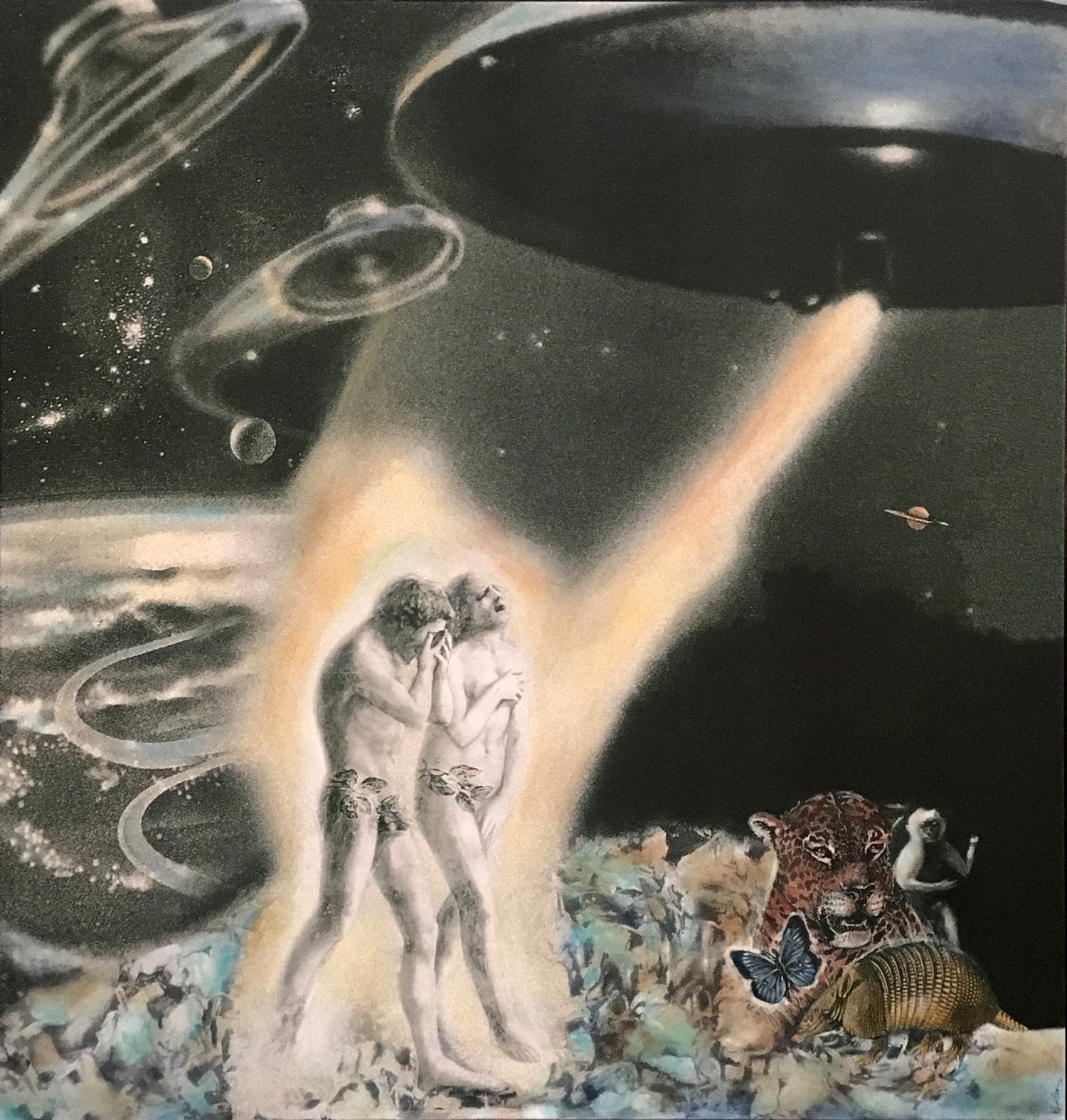
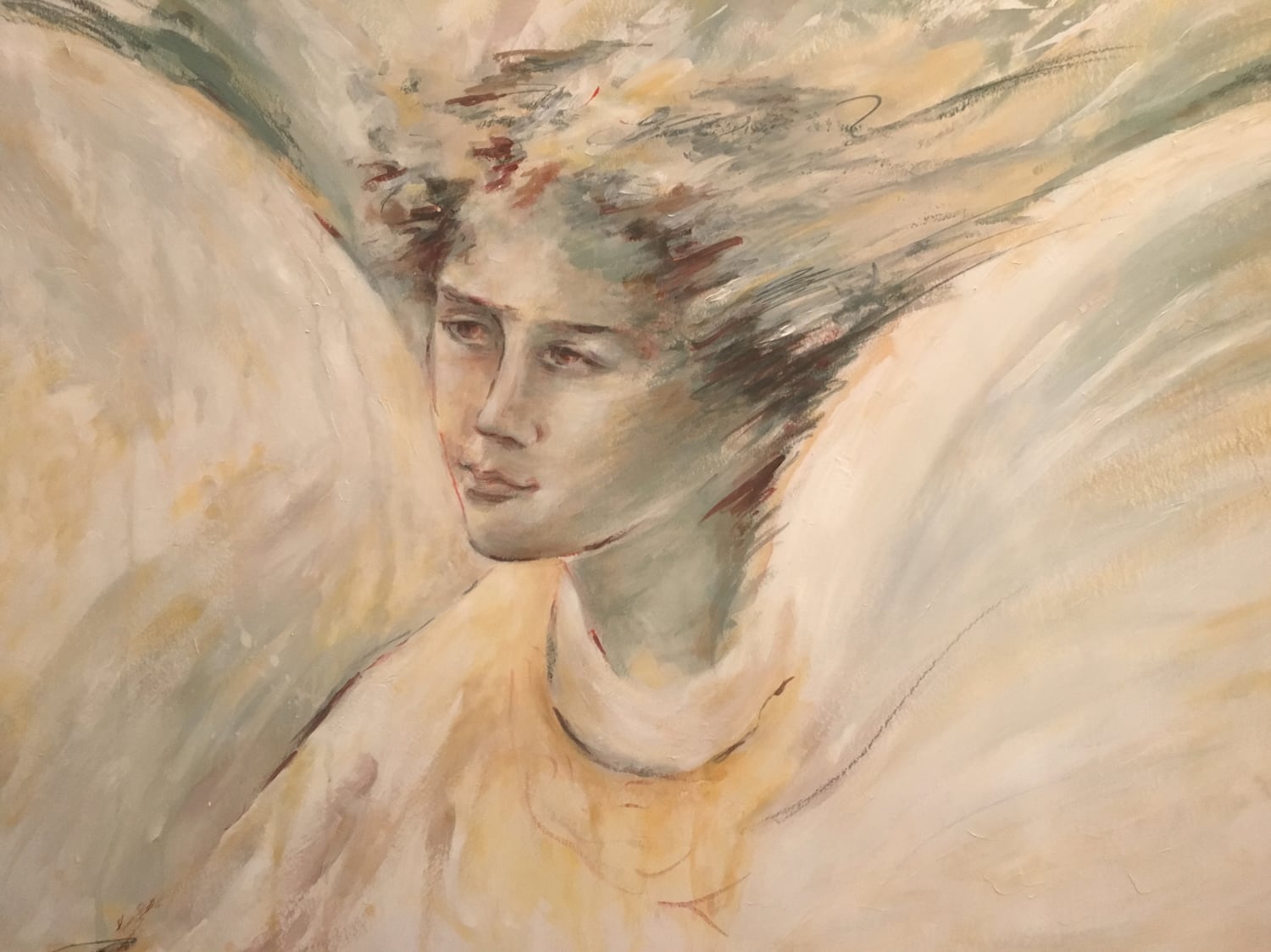


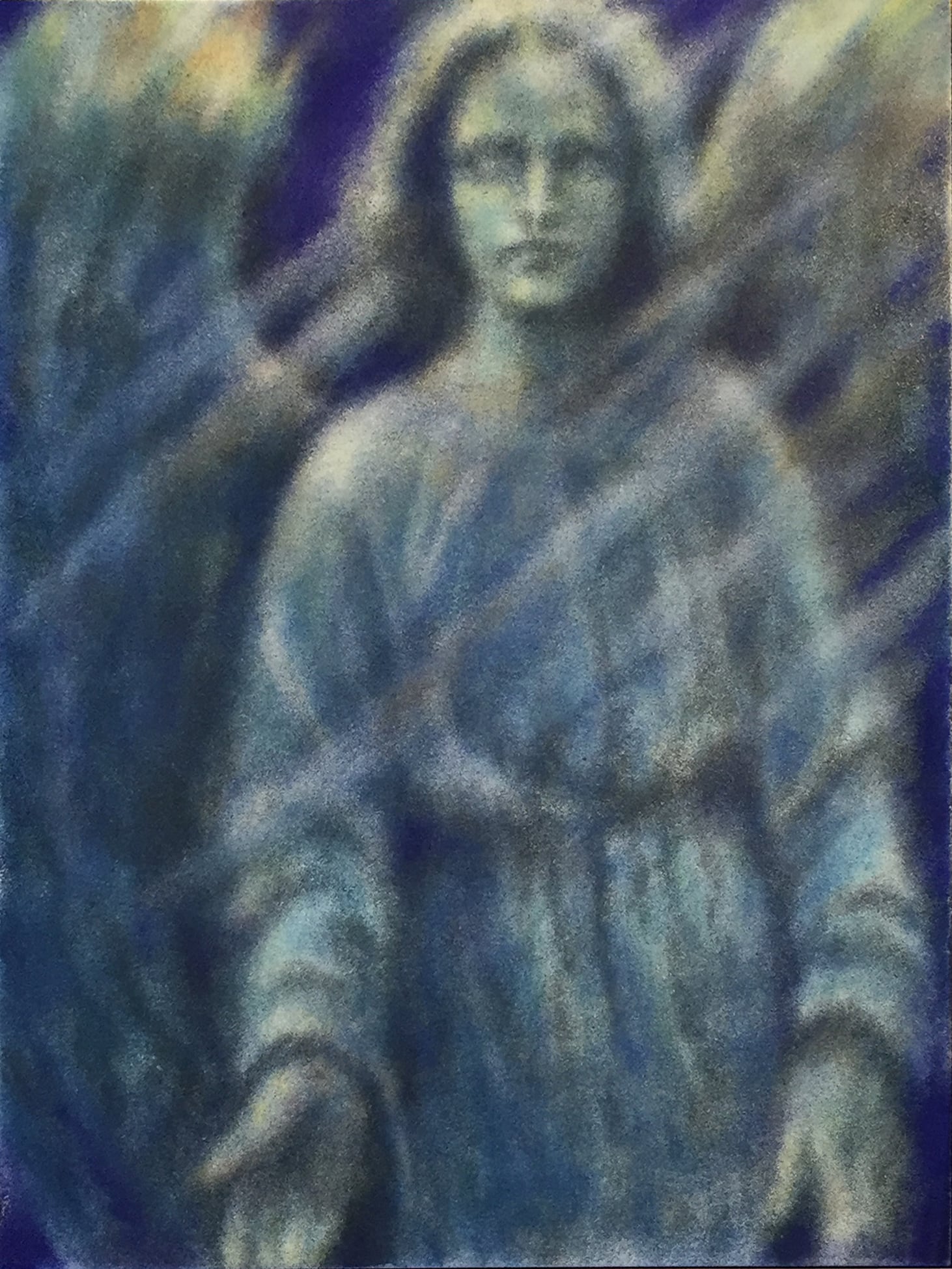



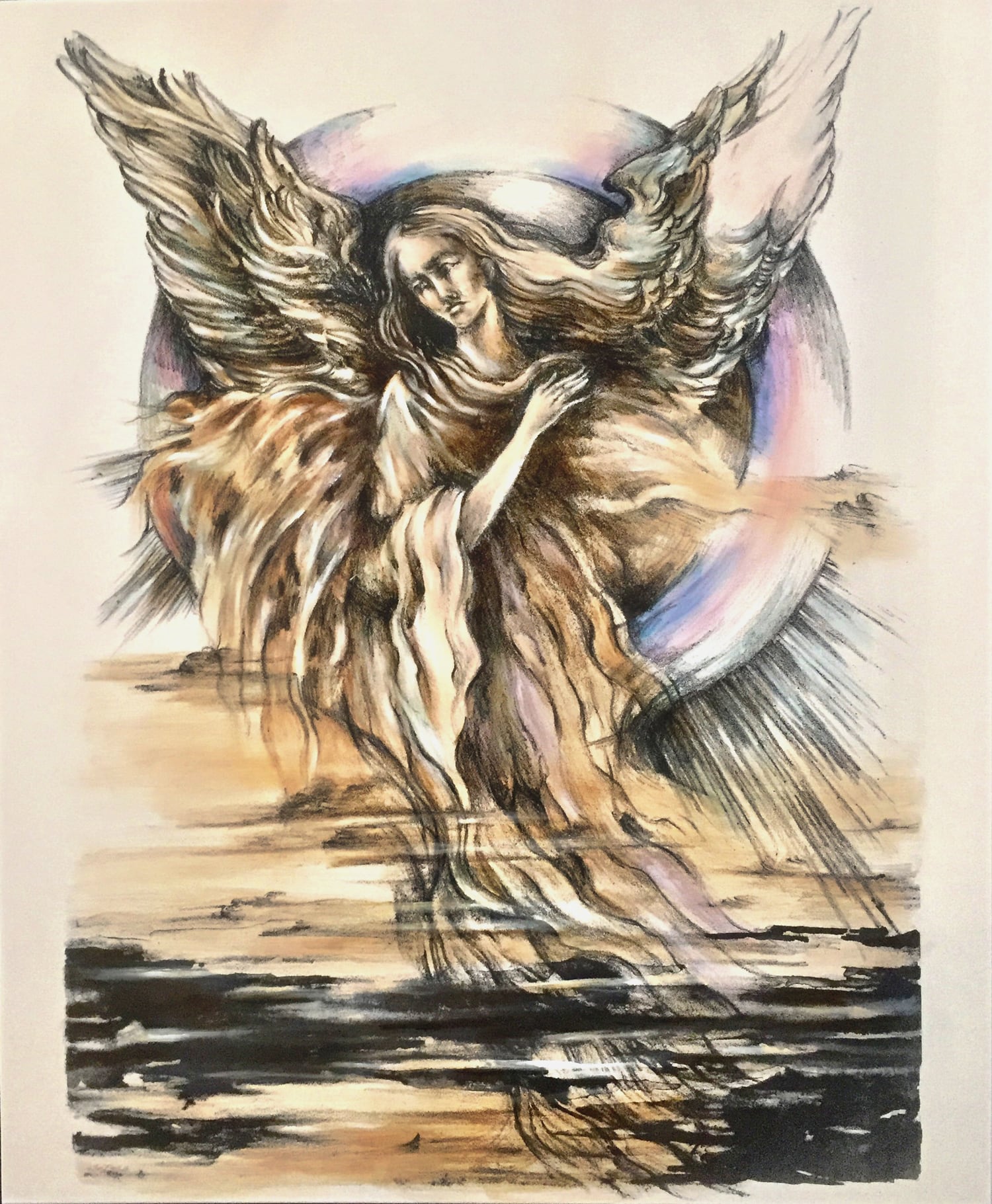





AMAZÔNIA IMAGINED
“IT IS AN ARTIST’S DUTY TO SEE BEYOND THEIR EYES”

The Amazonian Indian see beasts such as the jaguar, or the planets tracing paths in the sky, as articulate personalities, as much part of their extended family as tribal siblings.
It is this quality of belonging that Kim Poor seizes, in a magical series of pictures that have already been widely exhibited in her native country. She fuses her work with the legends of Amazonia to become part of them, an inseparable component of the complex Amazonian matrix.
The paradox is that she chooses highly technological means of doing this. An extremely demanding medium - glass and pigment - fused, with ferocious heat, onto steel. Once fired the glass particles cling firmly and produce colours of astonishing depth and translucency.
Kim Poor is looking for a way of finding true, durable equivalents for the colours and textures of the Amazonian rainforests and for the shimmering hues of the creatures that inhabit them.
Light strikes through the surface of painting created with glass powder and is reflected back from the metal ground. This gives Kim Poor’s work its characteristic glow and depth. It changes unpredictably as light strikes from different angles or with varying degrees of intensity.
The bloom of the colour is enhanced by another special characteristic, an absence of outlines. Forms are built from minute speckles of colour; the image has no firm boundaries. Subtle optical variability is one of their chief properties - the spectator’s eye is never quite at rest. One is always in dialogue with an ever-shifting surface. This, the images tell you, is what happens when you look, and hold your breath. The magical moment is yours forever, just as it was for the artist. The work offers an almost frightening sense of permanence, given the recalcitrant materials from which it is made.
The dreamlike quality of Kim Poor’s work does, of course, tend to align itself with things that have often aroused comment both in Latin American art and in Latin American literature. In a broad sense we have here yet another example of Magical Realism that can be found in the work of great contemporary Latin American writers such as Gabriel Garcia Marquez, Mario Vargas Llosa and Isabel Allende. Her work shares with theirs not only a dreamlike atmosphere but an undoubted, though often oblique, narrative thrust and, at the same time, a typically Latin American concern with urgent contemporary problems: in this case the ecological problems that threaten the whole Amazon basin, and the tribal peoples who live there.
Edward Lucie-Smith
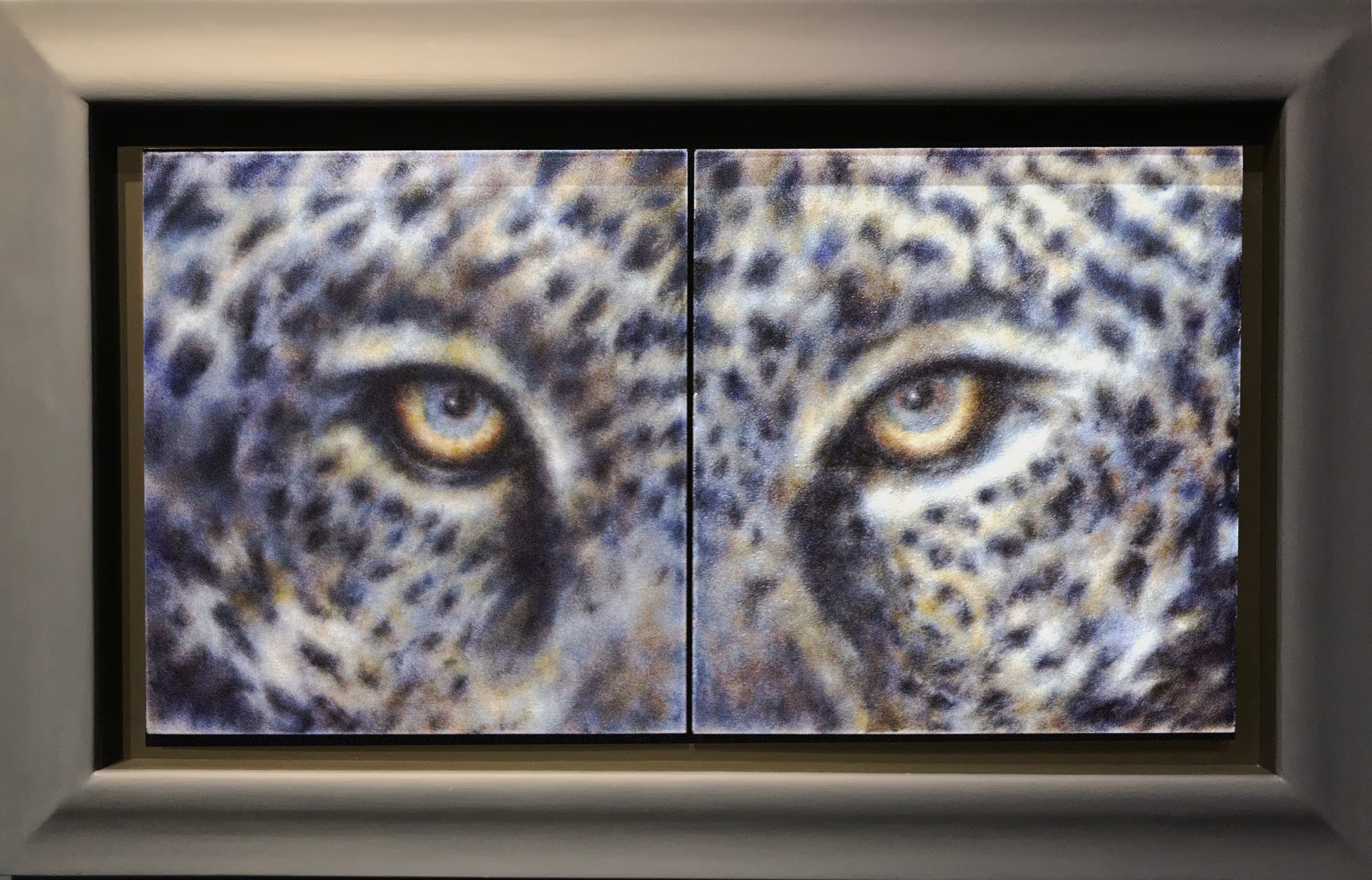
Blue Jaguar “I can see”
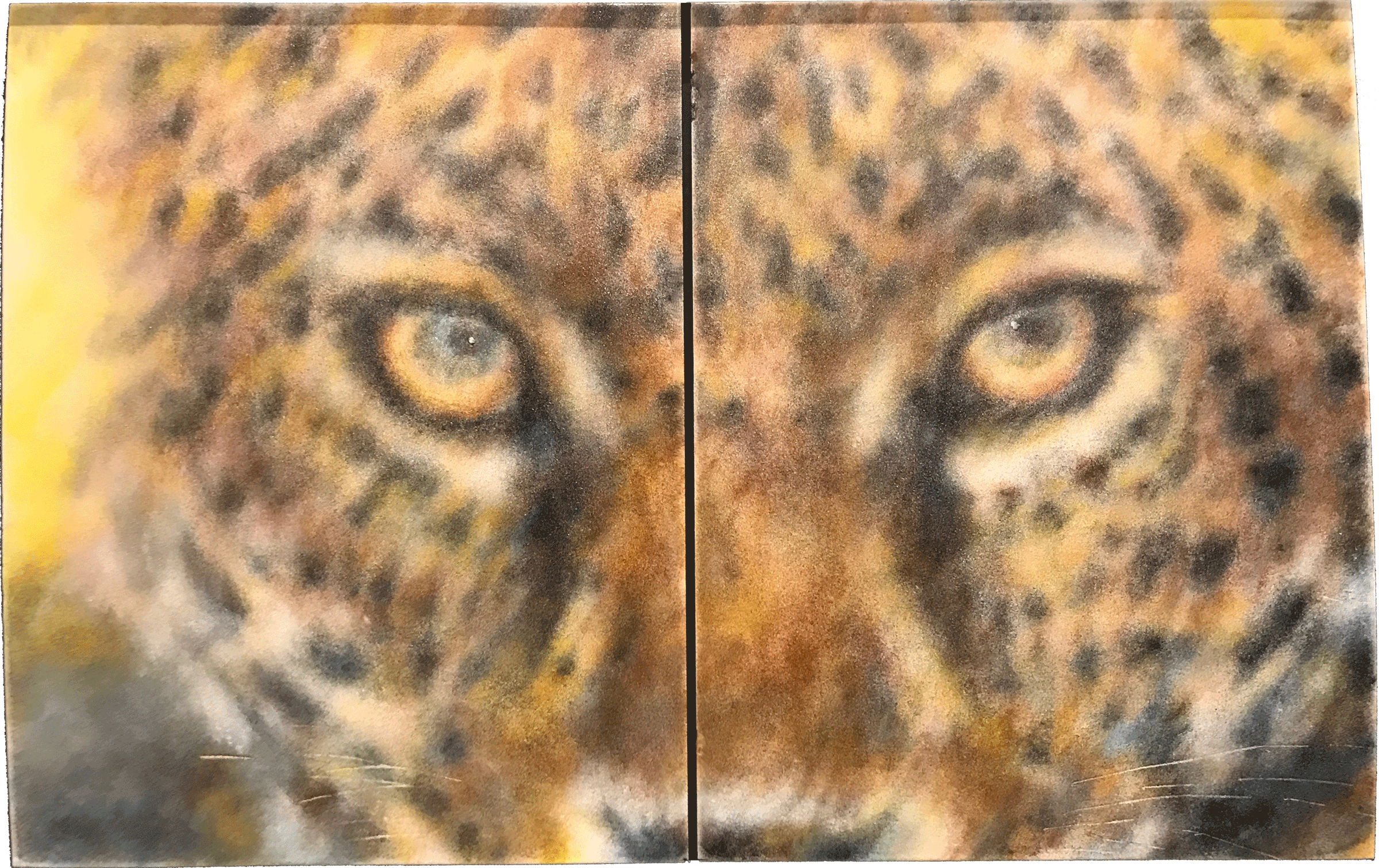
Yellow Jaguar “Give your eyes to me”
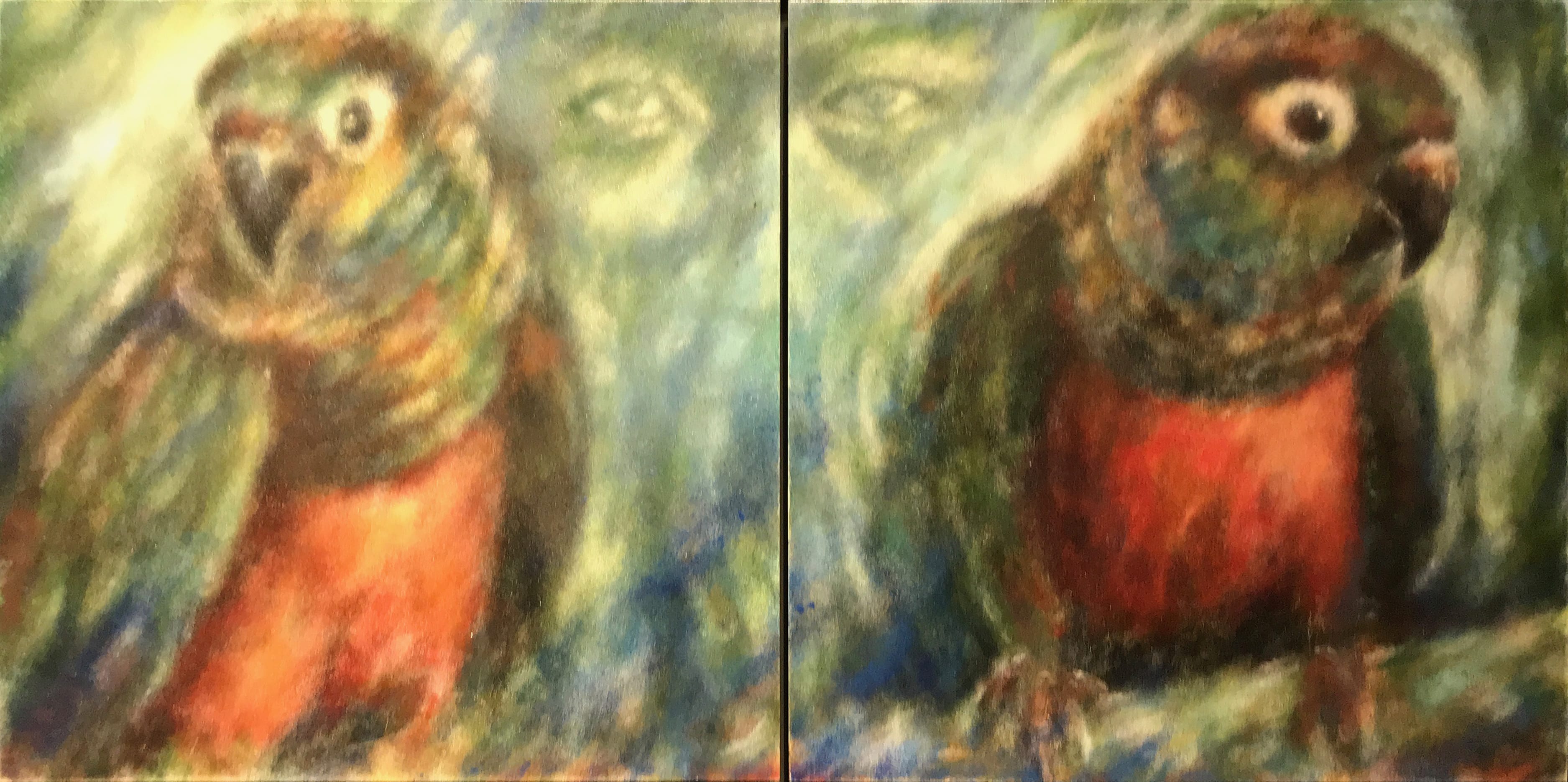 Parrots “Warning from Kanaxiwe”
Parrots “Warning from Kanaxiwe”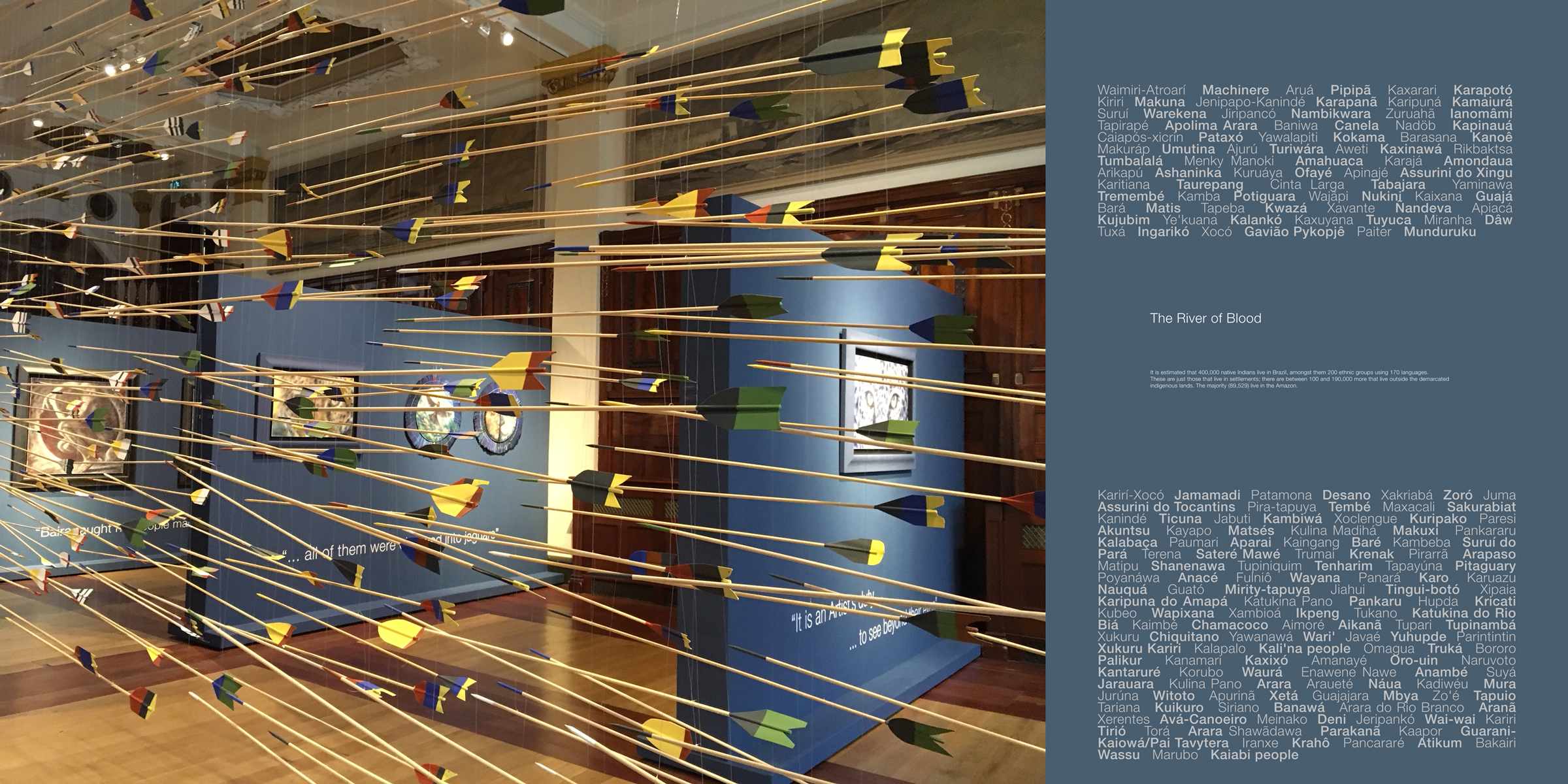
The River of Blood

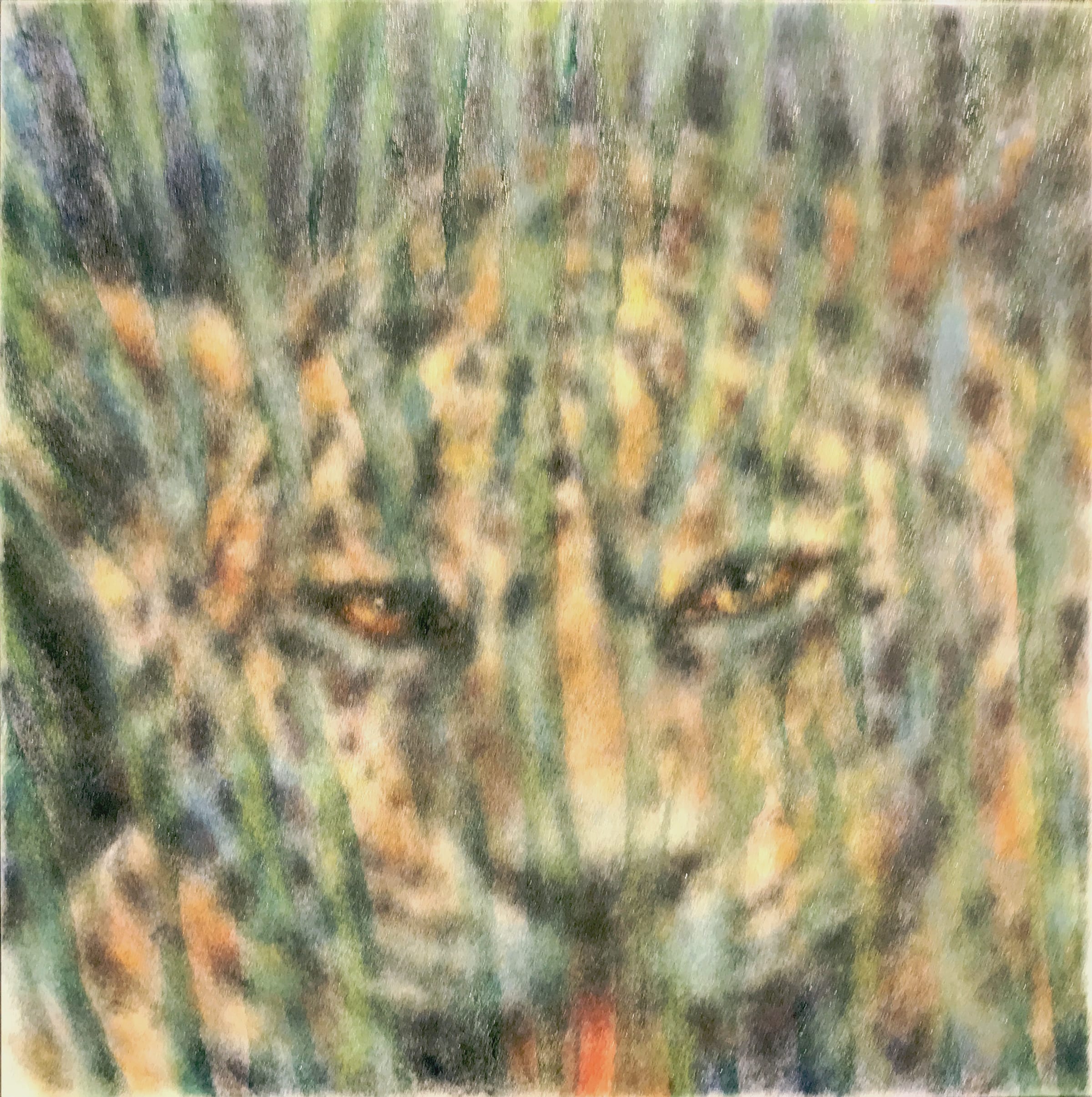
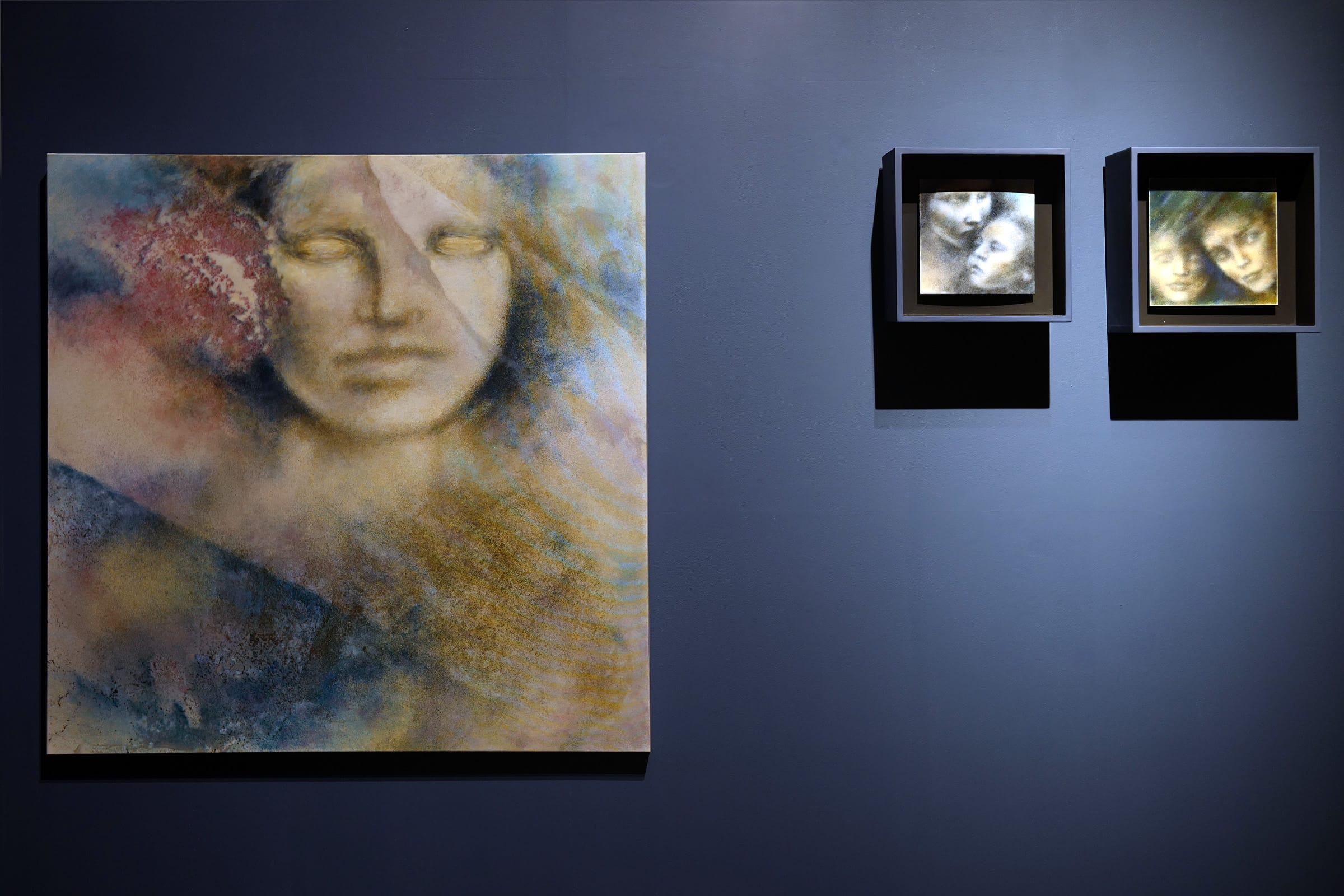



 Resurrection Wall
Resurrection WallAmazônia Imagined
by Edward Lucie-Smith
Available now from Amazon · BookDepository · Waterstone's · WH Smith · Blackwells
“AMAZÔNIA IMAGINED IS AT ONCE A CELEBRATION AND A LAMENT FOR SOMETHING PRECIOUS THAT IS ABOUT TO VANISH FROM THE FACE OF THE EARTH”
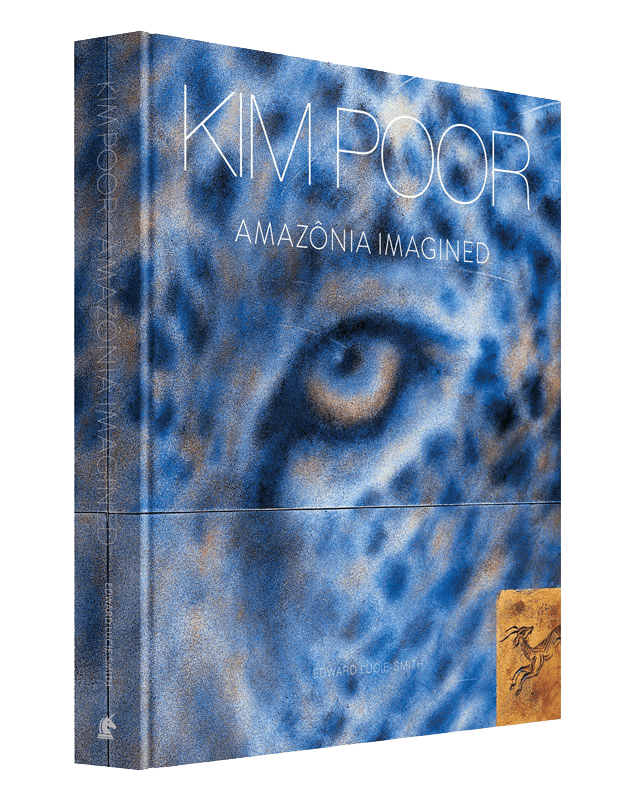
“IT IS AN ARTIST’S DUTY TO SEE BEYOND THEIR EYES”
Amazônia Imagined brings together the work of Brazilian artist Kim Poor and the text of art historian Edward Lucie-Smith.
An important and beautiful document, it preserves a vital link to the past that is stored in the minds of the Amazonian peoples. It is a book that will have an instant appeal for those who are interested in the preservation of the Brazilian rainforest and the fate of the native Amazonian Indian. An elegantly conceived and executed tribute to these indigenous peoples and to this Brazilian artist’s inimitable and pioneering technique, named ‘Diaphanism’ by Salvador Dali.
Edward Lucie-Smith is generally regarded as the most prolific and the most widely published writer on art. A number of his art books, among them Movements in Art since 1945, Visual Arts of the 20th Century, A Dictionary of Art Terms and Art Today are used as standard texts throughout the world.
Kim Poor is a Brazilian artist working in London and Rio. She has exhibited all over the world, including major solo shows at the Museum of Modern Art in Rio and in São Paulo with her Legends of The Amazon multimedia exhibition, raising awareness of something precious which is about to vanish from the earth. In the 70s Salvador Dali christened her technique of fusing glass powder on steel plate ‘Diaphanism’ and her CV also includes over 30 record sleeves and a book illustrating music by the English group, Genesis.
Unicorn Press is an independent publisher producing high quality illustrated books on art, cultural history and military history. Working with many well known artists such as Maggi Hambling and David Inshaw and estates such as Laurie Lee, H E Bates and Gavin Maxwell the list represents all that is best in modern art and culture as well as re-publishing some of the classic works of the 20th century.
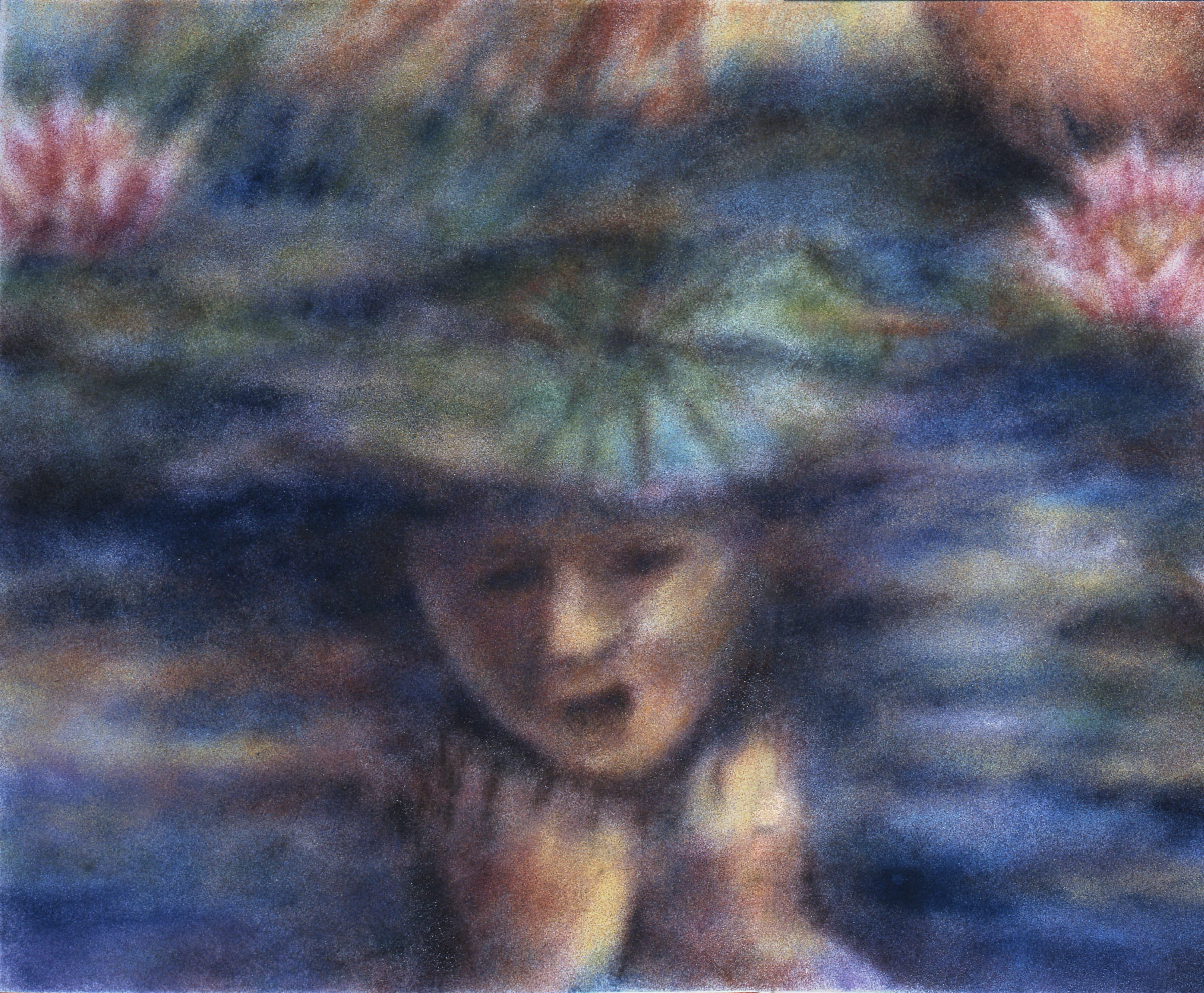
The Amazonian Indian see beasts such as the jaguar, or the planets tracing paths in the sky, as articulate personalities, as much part of their extended family as tribal siblings. It is this quality of belonging that Kim Poor seizes, in a magical series of pictures that have already been widely exhibited in her native country. She fuses her work with the legends of Amazonia to become part of them, an inseparable component of the complex Amazonian matrix.
The paradox is that she chooses highly technological means of doing this. An extremely demanding medium - glass and pigment - fused, with ferocious heat, onto steel. Once fired the glass particles cling firmly and produce colours of astonishing depth and translucency.
Kim Poor is looking for a way of finding true, durable equivalents for the colours and textures of the Amazonian rainforests and for the shimmering hues of the creatures that inhabit them.
Light strikes through the surface of painting created with glass powder and is reflected back from the metal ground. This gives Kim Poor’s work its characteristic glow and depth. It changes unpredictably as light strikes from different angles or with varying degrees of intensity.
The bloom of the colour is enhanced by another special characteristic, an absence of outlines. Forms are built from minute speckles of colour; the image has no firm boundaries. Subtle optical variability is one of their chief properties - the spectator’s eye is never quite at rest. One is always in dialogue with an ever-shifting surface. This, the images tell you, is what happens when you look, and hold your breath. The magical moment is yours forever, just as it was for the artist. The work offers an almost frightening sense of permanence, given the recalcitrant materials from which it is made.
The dreamlike quality of Kim Poor’s work does, of course, tend to align itself with things that have often aroused comment both in Latin American art and in Latin American literature. In a broad sense we have here yet another example of Magical Realism that can be found in the work of great contemporary Latin American writers such as Gabriel Garcia Marquez, Mario Vargas Llosa and Isabel Allende. Her work shares with theirs not only a dreamlike atmosphere but an undoubted, though often oblique, narrative thrust and, at the same time, a typically Latin American concern with urgent contemporary problems: in this case the ecological problems that threaten the whole Amazon basin, and the tribal peoples who live there.
Edward Lucie-Smith

Can Utility and The Coastliners
“Those who love our majesty show themselves!”
Kim Poor and Genesis
Kim Poor first encountered Genesis in New York in 1974 and went on to marry their guitarist, Steve Hackett. She toured extensively with the group in the following years and was commissioned to illustrate a book of their lyrics.
Along the way she also introduced them to Brazil, where years later the group’s vocalist, Peter Gabriel, was to make an early foray into ‘World Music’ when he recorded his classic ‘Mercy Street’, using a Brazilian bayonne rhythm suggested by one of Kim’s childhood friends. One of Poor’s paintings, “Entangled”, was also to provide the lyrical inspiration for the Genesis song “Entangled”.
Their strong visual show, their lyrics and music had a strong effect on her. From the moment she showed her work to them it was clear that her paintings and their music had particular affinities - a common ground of feeling, taste and inspiration. Genesis, known for their ethereal music, pioneered the use of visual theatrics in rock performances, creating a continuity of sound and vision, music, literature and art. This marriage of word and picture inspired Kim to create a book of lithographs, watercolours, oils, etchings, egg tempera and glass on steel - 'Genesis Lyrics'. These were the responses of a young Brazilian artist to the mythology-driven English Public School rock music of the 70s.
There is today substantial historical interest in the period and its culture and the major representatives of that scene were undoubtedly the English band Genesis. They emerged from Charterhouse, producing major artists such as Peter Gabriel, Phil Collins and Mike Rutherford and influenced a generation of musicians. Of all the era’s bands Genesis most encapsulated everything that was lyrically whimsical and musically progressive.
Rock music at its root shares with painting, sculpture and all visual arts the ability to reach vast numbers of people. Its persuasive power, like Kim Poor's images, rests on hints and suggestions that set the mind a-floating in a dream state. Both artist and band shared a love of irony and the bizarre, thus conjuring images that allow the melodies to flow freely and entice the imagination of the viewer. Their shared influences are as eclectic as the English tradition of Romanticism, the Pre-Raphaelites, the dreams and nightmares of William Blake, the Magic Realism of South American writers Gabriel Garcia Marques and Paulo Coelho.
Kim Poor produced in many mediums - oil, watercolour, egg tempera, lithographs and her own renowned enamelling technique that was baptised by Salvador Dali as Diaphanism in the 70s.
Her record sleeve for ‘Please Don't Touch’, for example, was inspired by the eccentricities found in the Jack Donovan automata shop on the Portobello Road. This was filled with bizarre dolls, toys and Victorian automated music boxes. In the 70s it was a hub that, on entering, transported you back to childhood with all the wonder and cruelty that could be found in old fairy tales. That sign, ‘Please Don’t Touch!’, was all over the shop, as if to serve as a menacing warning of what could happen if disobeyed. This painting was to influence director Ridley Scott when he produced the toy and puppet sequence in Bladerunner.
You can read some of Kim’s reminiscences of those times in her blog “Visions of Angels”.
Kim Poor and Steve Hackett - A Brief History Of An Extraordinary Partnership
Genesis Lyrics paintings ...
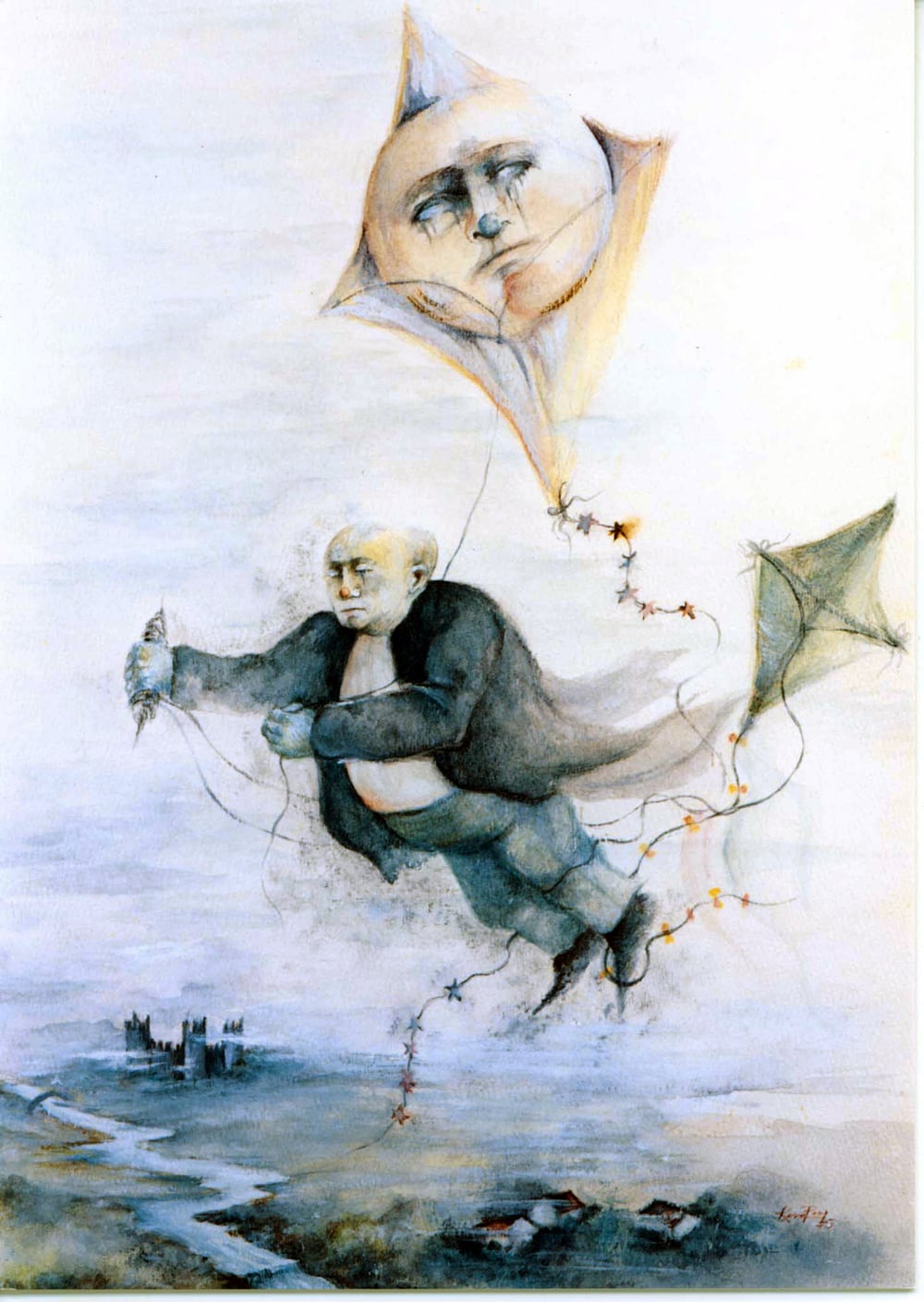
Entangled
“Sentenced to drift far away now. Sometimes entangled in your own dreams”
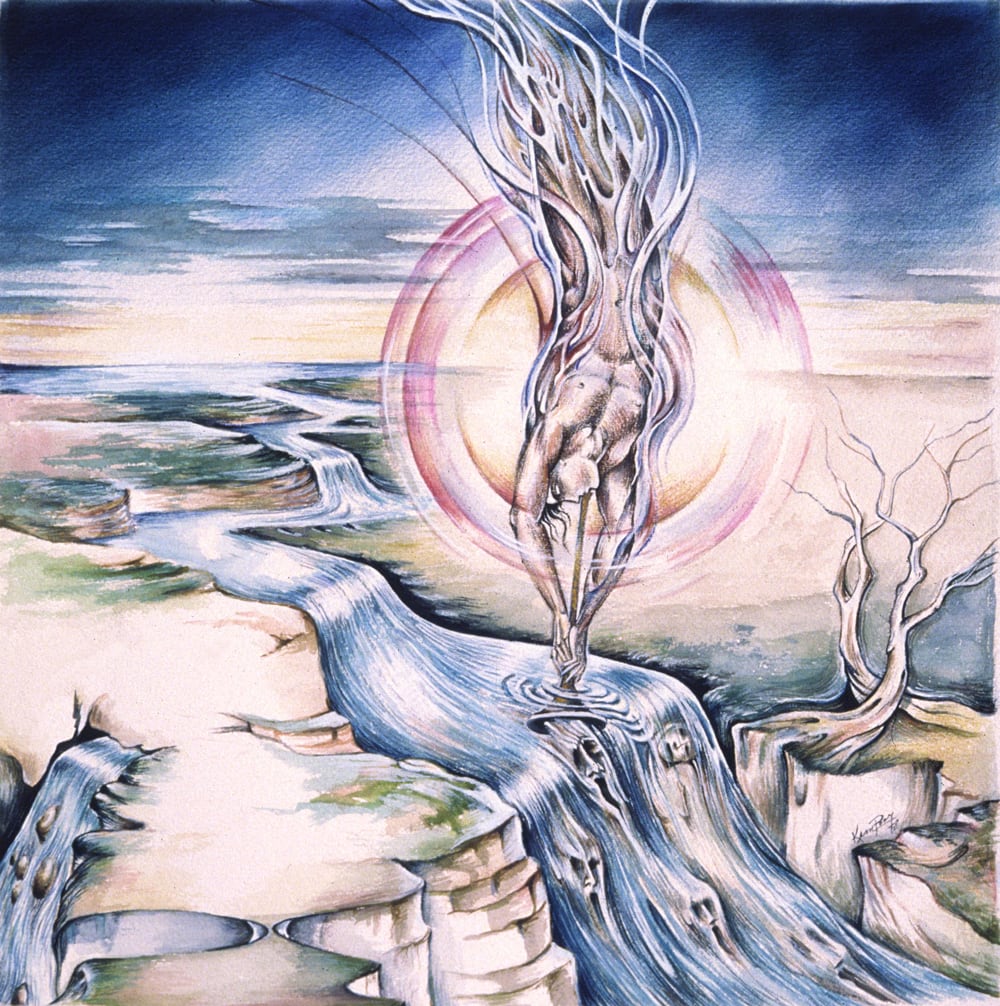
Apocalypse In 9/8
“Gonna blow right down inside your soul”
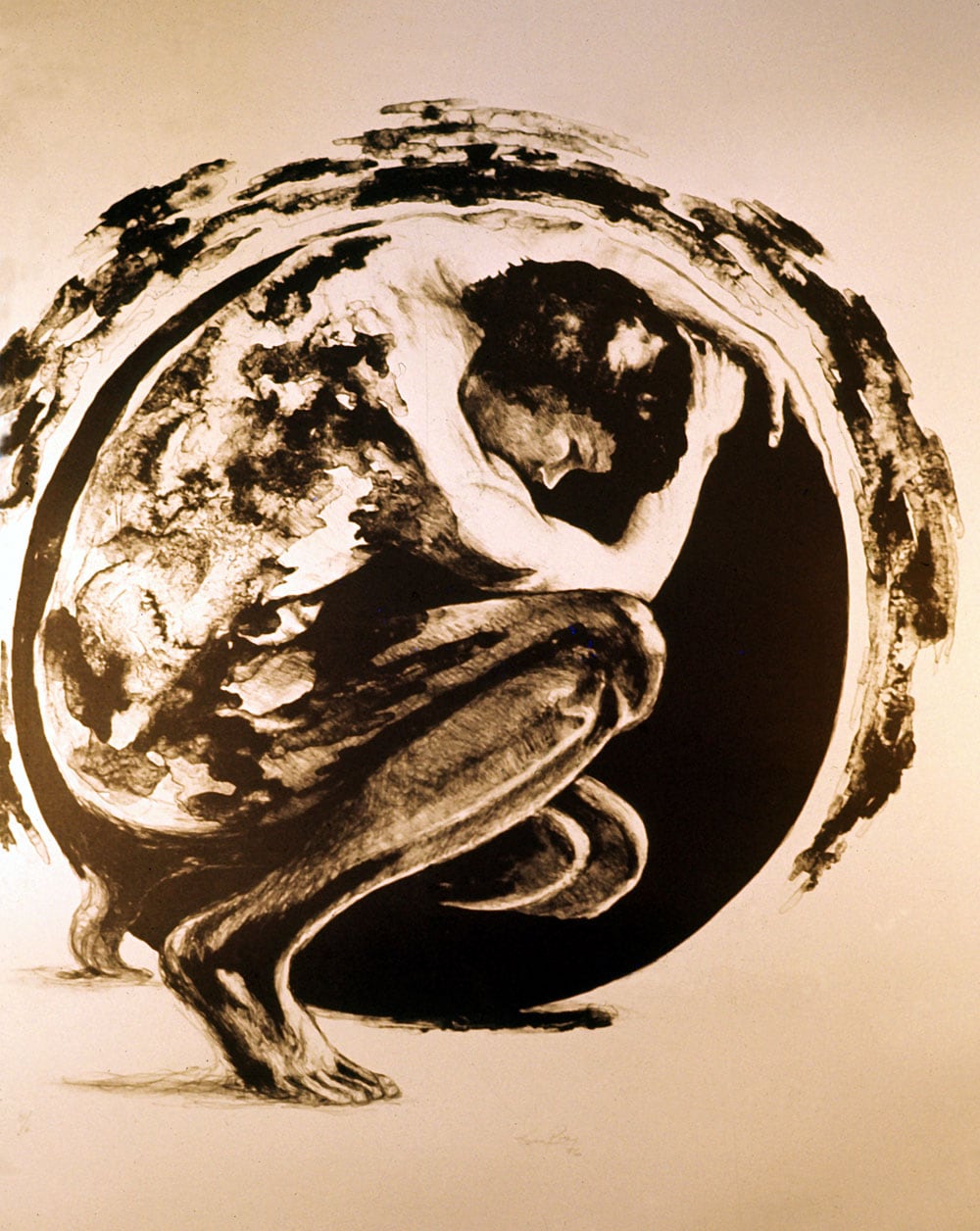
After The Ordeal

Visions of Angels
“Visions of Angels all around, dance in the sky”
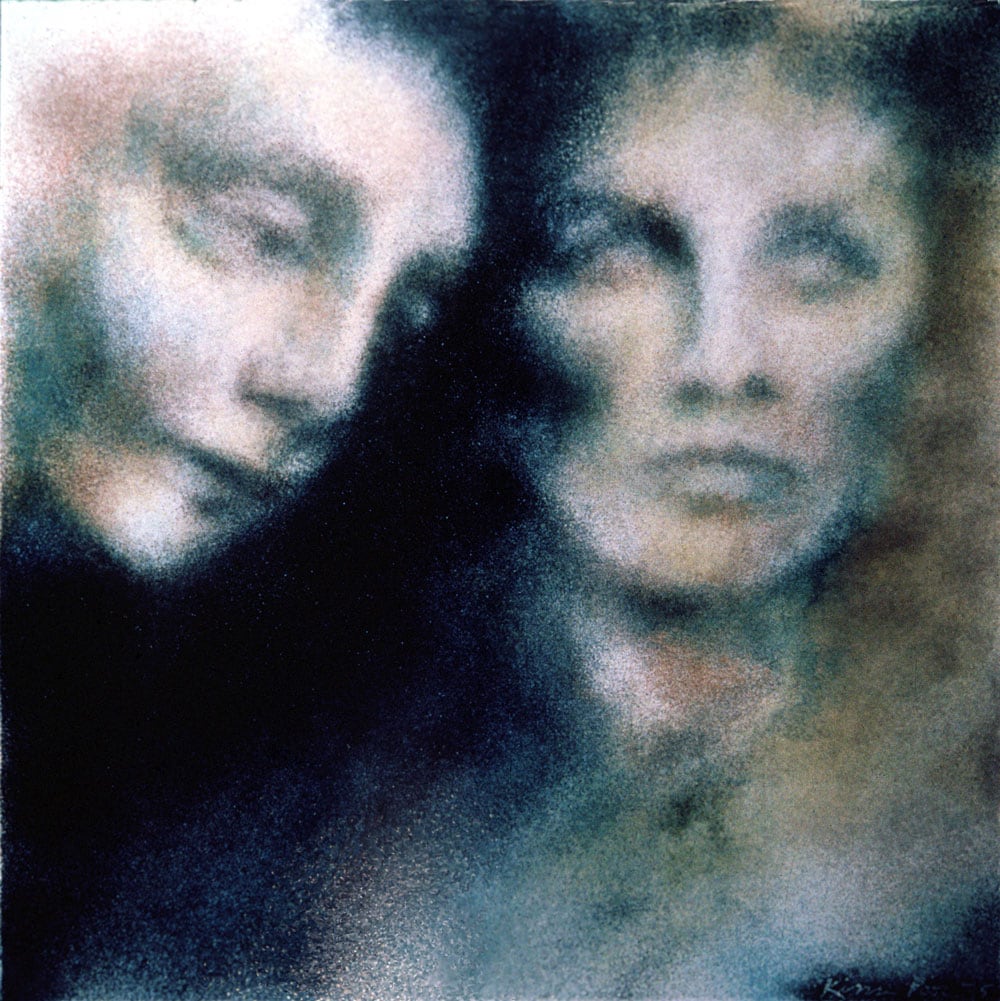
More Fool Me
”Here am I. Who while away the mornings since you’ve gone”
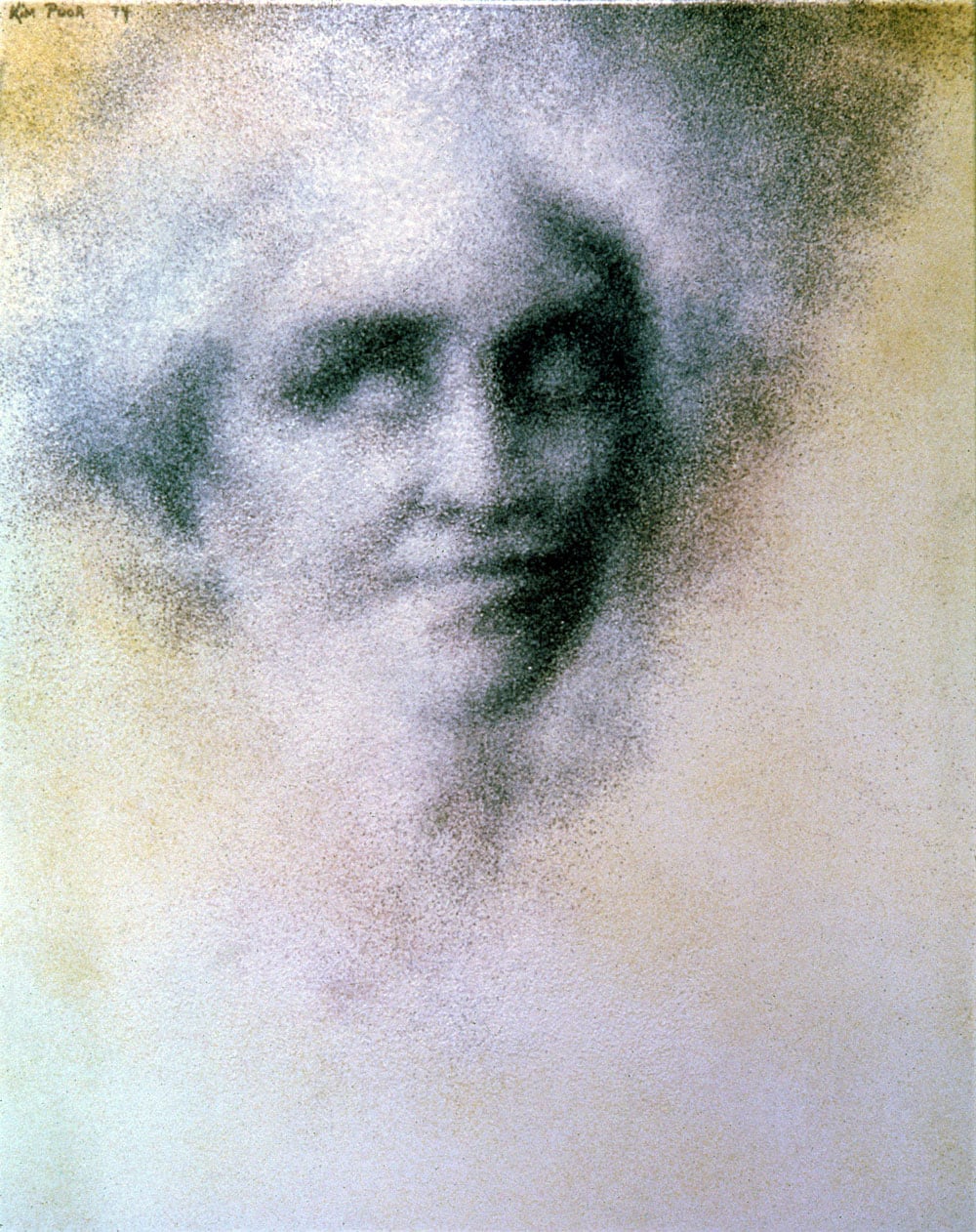
For Absent Friends
“Years seem so few”

Harold The Barrel
“Harold the Barrel cut off his toes and he served them all for tea”

Firth of Fifth
“Though no eyes can see the course laid down long before, the scene of death is lying just below”

Blood on The Rooftops
“Dark and grey, an English film, the Wednesday play”

Afterglow
“But I, I would search everywhere just to hear your call”

Eleventh Earl of Mar
“A voice screams, seems to be calling. The face turns, features are burning.”
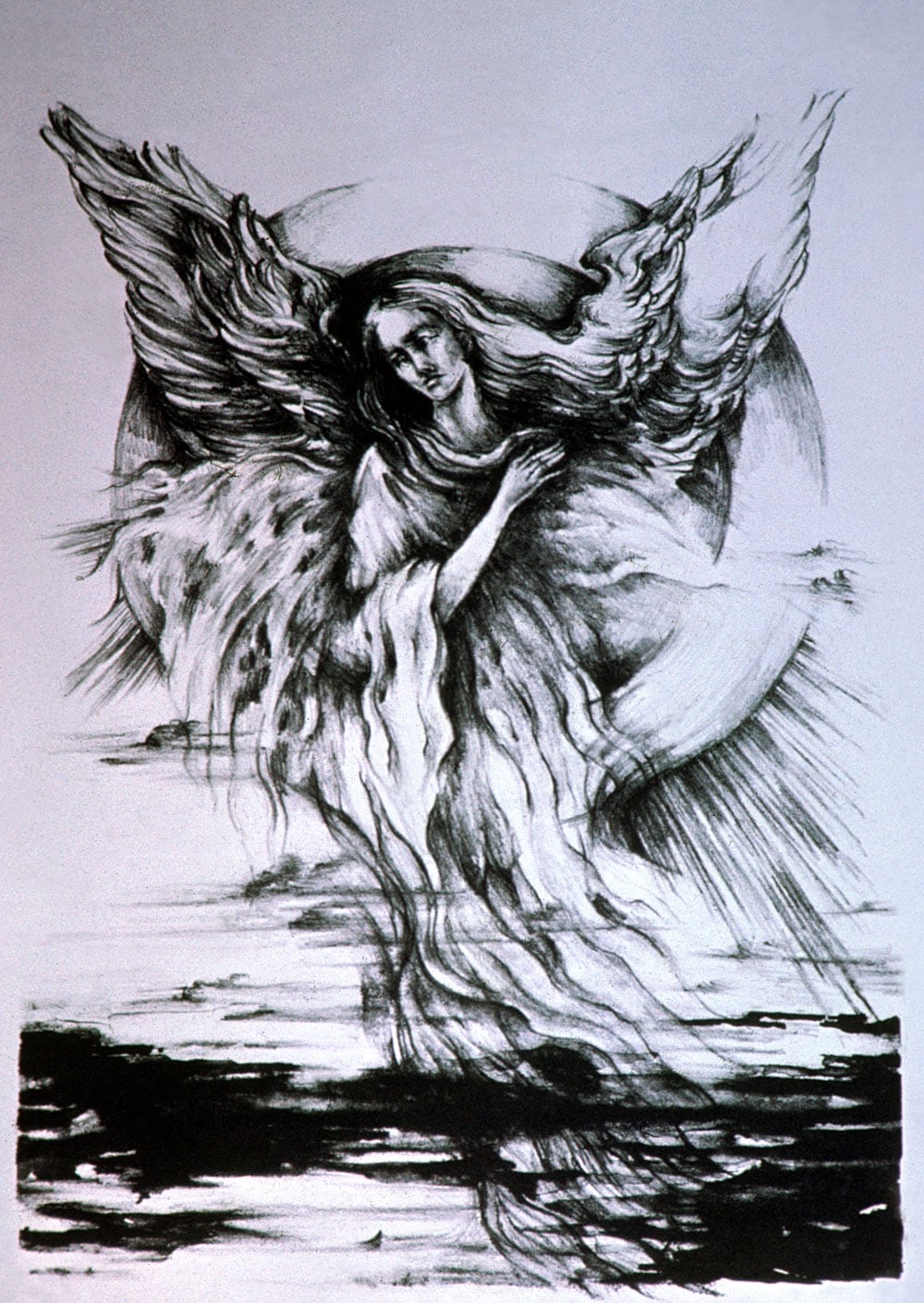
Watcher of The Skies
“Watcher of the skies, watcher of all ...”

Harlequin
“Blest are they who smile from bodies free”
Letter from Genesis’ management commissioning Genesis Lyrics
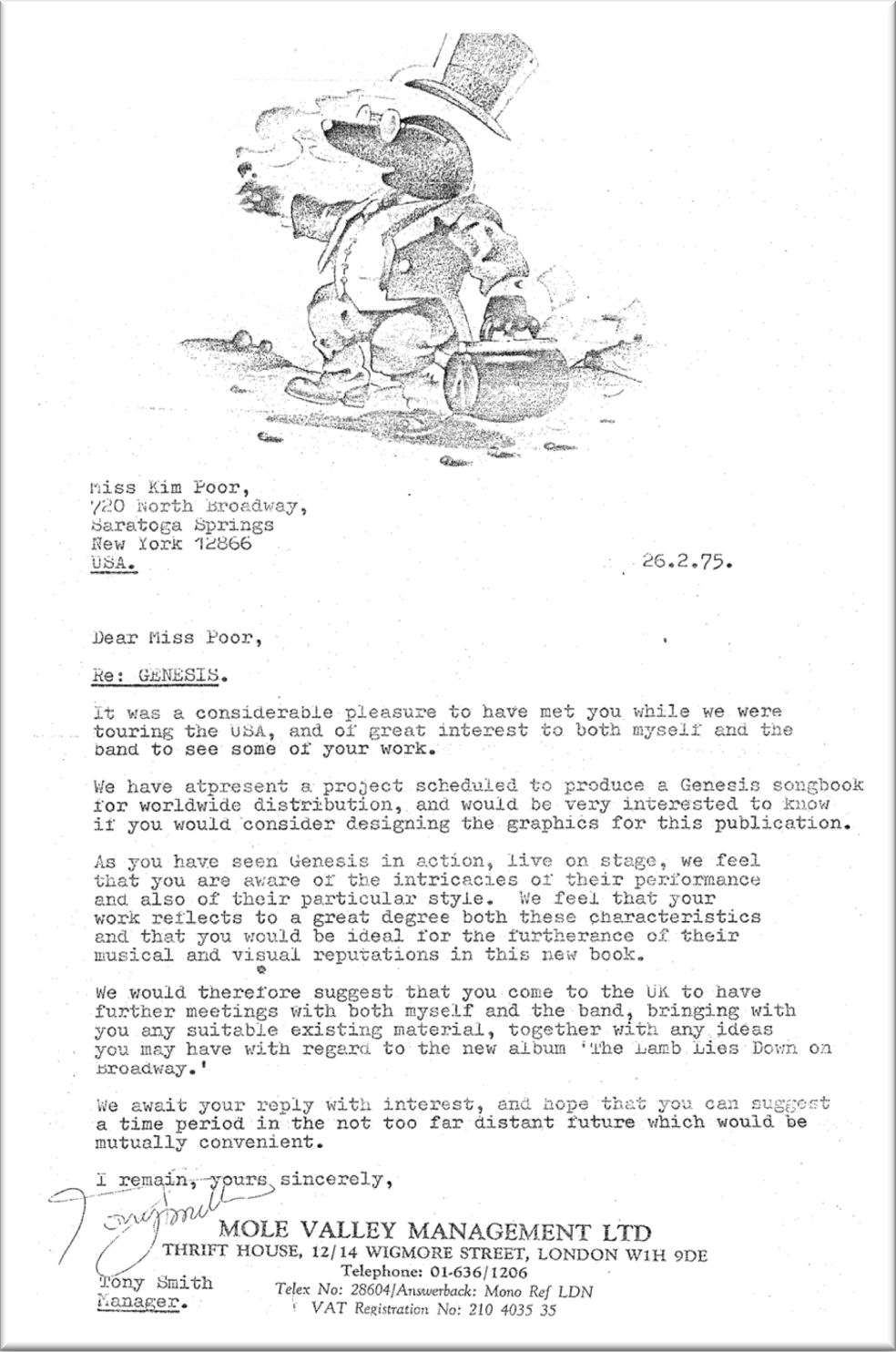
Copyright © 2017 Kim Poor, All rights reserved.
All images Copyright © 2017 Kim Poor, All rights reserved.
All images Copyright © 2017 Kim Poor, All rights reserved.